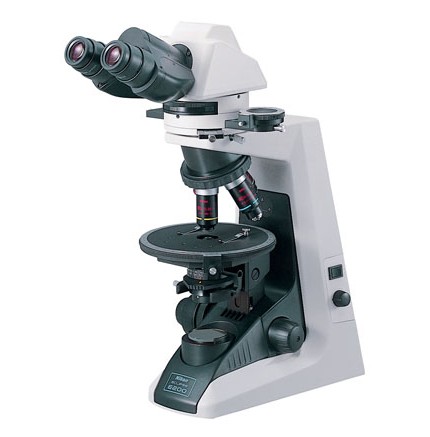Contents
Overview of Polarizing microscopes
- Polarizing microscopes are used for medical applications like Rheumatology to view crystals in urine (gout); industrial applications like detecting defects in semiconductors or finding stress points in metal and glass; geology – studying meteorite thin specimens; biochemistry, biomedical research, and petroleum or oil industry (mud logging) – which include studying fibers suspended in liquid or analyzing content and chemical makeup of many alternative organic and inorganic materials.
- Polarizing Microscopes (PLM) uses two filters; a polarizer, positioned in the light path a fewwhere before the specimen (usually fixed to a left-right, or East-West position) and an analyzer (a second polarizer), placed in the optical pathway between the objective rear aperture and the observation tubes or camera port, set to a North-South position, though it can be rotated on a few microscope models.
- Polarizing Microscope with large stable microscope base and limb with graduated coaxial coarse and fine focusing (with safety stop), rack and pinion focusing condenser mount, Equipped with strain free condenser and strain free 4x, 10x, 40X objectives with pre-centered transmitted and incident 6V 30W light intensity Halogen lamp with variable intensity control.
- A polarizing microscope is built with a polarizer and an analyzer that is used to pick up light differences after the light is polarized, refracted through the specimen which then makes the light waves become out of phase.
- Polarizing microscopes use both an analyzer and polarizer to cross-polarize the light and pick up differences in the colors in the optical path of the specimen being examined.
- Polarizing microscopes are based on this idea: they’re much like ordinary optical microscopes but with polarizing filters fitted above and below the specimen.
- Polarizing microscopes employ polarized light that show changes in internal structure and composition of material not discernible with ordinary light.
- Polarizing microscopes are designed to image samples which are visible primarily due to optical anisotropy, or measurable differences in refractivity.
- Polarizing microscopes use polarized light along with transmitted and, or reflected illumination to examine chemicals, rocks, and minerals.
- Polarizing microscopes are utilized by geologists, petrologists, chemists, and the pharmaceutical industry on a daily basis.
How do Polarized Light Microscopes Work?
Polarized light microscopy enhances image contrast and improves image quality in comparison to other microscopy methods, such as differential contrast, phase contrast, and fluorescence microscopy.
How Does Polarising Light Microscopy Work?
Light waves are omnidirectional and will vibrate out at an angle perpendicular from the direction in which the beam is transmitted. So when you turn on the microscope’s light source, light moves upwards and is polarised to move in one direction by the polariser. This causes all light passing through to be blocked, except for those light waves that vibrate in parallel with their privileged (light passing) directions.
Not sure which type of microscope is best?
High power microscopes go to 400x and beyond and are used to look at specimens you can not view with the naked eye. Samples are placed on microscope slides and covered on top with a “cover slip. ” High power microscopes are more popular as gifts than low power microscopes as there are more activities and investigations that can be done with them. Our two most popular (high power) models sold as gifts are the student microscope 24 slide kit package and the HS-1M High School Microscope. If you want to look at larger items (greater than 2mm) such as a whole insect, coins, stamps, gems minerals or sand grains then you should look at the low power microscopes. Our two most popular low power microscopes are the S2-BL stereo microscope and the S6 Stereo Zoom Microscope. Digital microscopes perform the same functions, but also include a camera (in some cases a monitor) and software. You can connect the microscope to the computer to view a live image on your screen, as well as capture and save images and video! Recommend high power digital models are the MDS1-D digital middle school microscope and the HS-2D digital 1000x student microscope. Low power digital microscopes we recommend as gifts are the S6-LCD Stereo Zoom microscope and the S2D-SPS dual power digital stereo microscope.
What Is Polarised Light?
A regular light microscope uses unpolarised white light. This is the type of light that we see, and its waves vibrate in random directions. Polarised light, however, has waves that vibrate only in one direction, and cannot be seen by us normally.
What is Polarization?
Before getting into this techniques, it is helpful to think about what polarization is exactly, how it works, and what applications this technique is useful for.
WHAT POLARIZED ILLUMINATION CAPABILITIES DOES THE VHX HAVE?
Polarized illumination allows users to prevent glare and observe polarization properties. Depending on what lens is used, users are able to polarize bright-field, dark-field, and transmitted illumination.

